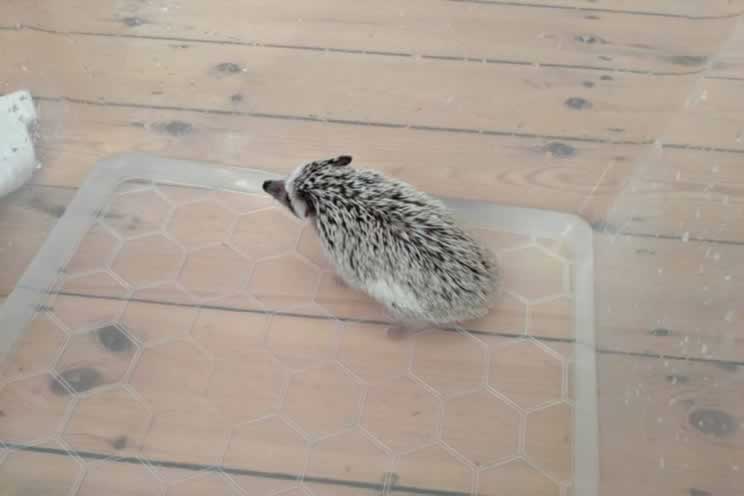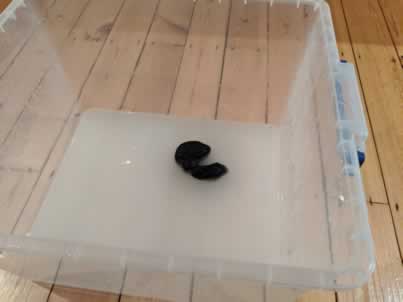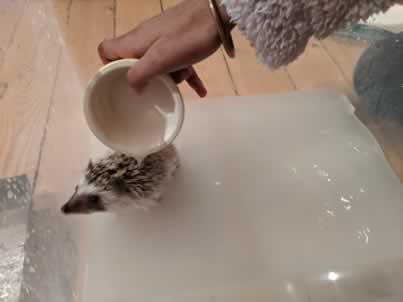
We’re often asked about how easy is it to bathe our hedgehog, as it looks difficult considering their prickly quills. We found it’s not too difficult to give them a bath as long as you follow some ground rules.
How often do you bathe your hedgehog? Hedgehogs need to be bathed at least once a month, with twice a month being common. Bathing can be done more often if the hedgehog gets dirty much more quickly, as long as the hedgehog doesn’t end up with their skin becoming too dry from the extra bathing.
It’s important to note, the cleanliness of this cage also plays an important part in us being able to maintain the fortnightly baths. If we didn’t have our daily poop cleaning, midweek light cleaning and weekly full cleaning then he’d get a lot grubbier and we’d be forced into giving him a bath.
Bathing is essential as they tend to end up with a lot of dried poop stuck to their feet and whilst this a cause for concern it can be easily managed with a cleaning routine for the cage and a fortnightly wash. Poop can also end up getting matted onto their underside fur and again a fortnightly wash can help clean this out.
How to bathe your hedgehog?
Bathing a hedgehog requires a little bit of thought as these creatures can end up suffering from dry skin if it’s not done properly. The following steps should help make this easy:
- Foot soak
- Poop removal wash
- Moisturizing wash
- Quill wash
- Drying time
- Treat time
By following these steps a routine can be established to not only make bathing easier but also more effective.
1. Foot Soak
The first part of bathing our hedgehog involves giving him a foot soak which not only gives an opportunity for him to soak his feet but also allows for the soaking of his fur on his underside softening any poop that’s got stuck there.
It’s also an opportunity for him to get used to the water and his bath time. We put warm water into a big plastic box to a point where it is no higher than where his underside (belly) starts, that’s about a centimetre (a third of an inch) of water for our hedgehog.
It’s always a slight shock to him when it’s bath time but the foot wash becomes a time when he poops and pees a lot as he gets used to what’s happening.
A two week period is a long time for a hedgehog to forget what good fun bath time is. He will also most likely drink some of the water before letting his body functions start, so we tend to not add anything to the water for his foot soak because he is likely to drink the water.
2. Poop removal wash
Once we feel comfortable he’s done his fill of poop and pee, we get him out and empty the big plastic box we use as his bath and give it a good rinse using just plain water. Then we add clean water, taking care it’s tepid and not too hot or cold, again we don’t fill this more than the height to his underside.
Now we use this part of his bathing to gently rub off any poop from his feet and legs, it’s a lot easier now as the prior wash has softened the poop. Any poop on his underside, in his fur easily comes off too. He’ll try to move around whilst we do this but we’ve become pretty persistent over the years to get poop off effectively.
3. Moisturizing wash
Once we’ve cleaned his feet and underside, we change the water again for some fresh clean warm water (again making sure it’s not too hot or cold) but this time we fill the water level up to what would be our hedgehogs chin, so he can keep his head above water and not struggle too much in the water.
We did when we first started bathing him put too much water in and he did not like that, he went frantic and even though hedgehogs can swim, he was in no mood to swim, so we took him out and poured some of the water away so he could still stand in it without struggling.
It’s important to use some form of moisturizer when bathing your hedgehog to help alleviate any issues with skin drying out later. You can use an off the shelf product like Aveeno with its colloidal oat (very fine oat particles) or you can use an old sock with oats (oatmeal) in it.
We use the latter method of putting oats into an old sock and letting this soak in his bathwater for about five minutes. We think this is effective, as we’ve not seen any tell-tale signs of dry skin on our hedgehog’s limbs like flaky skin.

The Aveeno product is very popular with eczema and psoriasis sufferers for its ability to provide moisturizing during washing. So it’s fair to say, it’s good enough for hedgehogs but make sure to take care of ensuring any products you use including Aveeno products, you check out the safety of ingredients in relation to hedgehogs first.
4. Quill wash
We let him run around the bath and he does at first try to climb out but the side of the plastic box is very steep, making him eventually realize he needs to grin and bear it, enjoy his bath instead of fighting it. The first plastic box we used for his bath wasn’t tall enough on the sides and he’d manage to climb out and make a run for it.

He’d also leave a trail of water as he tried to run away but by changing to a bigger box has allowed us to keep him in the ‘bath’ without him escaping.
We have found that when we scoop water up using a plastic cup (only used with our hedgehog and not used by us for personal consumption) and pour this on his back well away from his head, he stops and stands in the same position as if he’s frozen.

You can see his eyes blink, as the water seems to soothe him. This is one way we found to calm him down at bath times and stop him darting around, trying to escape. It’s also a good exercise for both me and my daughter to bond more with our hedgehog and it’s also quite therapeutic to watch him relax.

Sometimes we’ve accidentally poured water on his head and he does not like that, so we try to be extra vigilant when pouring the water over the middle of his back. When he’s fully relaxed when we’ve done this, he’s actually sat down on his hind legs and let the water flow over this back.
5. Drying time
Once our hedgehog has had his wash we take great importance in drying him thoroughly, especially in colder months as we don’t want him to be affected by the cold and wet fur will exasperate the cold effects more. My daughter wraps him up in a towel and uses the towel and her body heat by cuddling the towel to try and dry him quicker.
She’s very patient in taking her time with him to ensure he’s well dried before putting him back into the cage. It’s also advisable to do a full clean of the cage before you give your hedgehog a bath, as the last thing you would want to do it put your clean hedgehog back into a filthy cage.
Just remember your hedgehog will probably have a good sniff at his clean surroundings just to see if it’s home and this is another reason to make sure they are dry as this is another opportunity to get exposed to the cold.
We tend to put our heating on an hour before his bath in the colder months and keep it on until an hour after his bath, so for it’s quite a warm environment for him to bathe in. In the warmer months, it becomes easier to wash and dry hedgehogs as there’s less worry about it being cold.
6. Treat time
We also give our hedgehog a treat after he’s had his bath, with the view this probably helps associate having a bath is a good thing with a reward and not a bad thing that is a complete struggle.
Can bathing make a hedgehogs skin dry?
Yes, bathing a hedgehog more often can lead to dry skin forming on the hedgehog’s limbs as the water dries out the skin.
It’s important to also appreciate sometimes dry skin might not solely be caused by bathing too much and there may be underlying problems such as a fungal or bacterial infection, the dreaded mites or some other illness or disease-related issue. If the dry skin doesn’t clear up even after you’ve spread the bathing apart by two weeks then I suggest you consult with your vet to find out if there’s an underlying problem.
Twice a month is best
There are of course exceptions to bathing our hedgehog twice a month, as on some rare occasions he’s managed to get too much poop dried on his feet. So we’ve decided to give him an interim foot wash to get the poop off, as we don’t want too much-dried poop to cause him any injuries especially when he’s running on his running wheel.
We’re looking at putting in something to act as an island in his bath box, so he can climb onto it and then climb off. The idea behind this to give him some reassurance he can climb out of the water and hopefully, he’ll enjoy dipping in and out of the water. We haven’t decided what to put in yet and don’t want to put in anything that’s going to cause harm or might be too slippy.
Related Questions
How often do you have to clean a hedgehog? Cleaning a hedgehog usually involves bathing them at least twice a month on the proviso their cage is kept clean. A clean cage keeps the poop and pee from ending up on the hedgehog, causing them to smell.
Are hedgehogs hard to maintain? Hedgehogs are one of the easiest pets to maintain and establishing simple routines, looking after a pet hedgehog isn’t too difficult.


